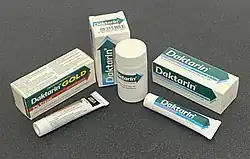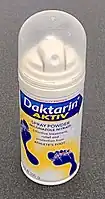Miconazole
| Names | |
|---|---|
| Trade names | Desenex, Monistat, others |
IUPAC name
| |
| Clinical data | |
| Drug class | Antifungal medication (imidazole)[1] |
| Main uses | Ring worm, pityriasis versicolor, yeast infections[1] |
| Side effects | Itchiness or irritation of the area[1] |
| WHO AWaRe | UnlinkedWikibase error: ⧼unlinkedwikibase-error-statements-entity-not-set⧽ |
| Pregnancy category |
|
| Routes of use | Topical, vaginal, sublabial |
| Defined daily dose | 200 mg (by mouth)[2] 1 gm (by injection)[3] 100 mg (vaginally)[4] |
| External links | |
| AHFS/Drugs.com | Monograph |
| MedlinePlus | a601203 |
| Legal | |
| Legal status |
|
| Pharmacokinetics | |
| Bioavailability | <1% after topical application |
| Protein binding | 88.2% |
| Excretion | Mainly faeces |
| Chemical and physical data | |
| Formula | C18H14Cl4N2O |
| Molar mass | 416.127 g·mol−1 |
| 3D model (JSmol) | |
| Chirality | Racemic mixture |
SMILES
| |
InChI
| |
Miconazole, sold under the brand name Monistat among others, is an antifungal medication used to treat ring worm, pityriasis versicolor, and yeast infections of the skin or vagina.[1] It is used for ring worm of the body, groin (jock itch), and feet (athlete's foot).[1] It is applied to the skin or vagina as a cream or ointment.[1]
Common side effects include itchiness or irritation of the area in which it was applied.[1] Use in pregnancy is believed to be safe for the baby.[5] Miconazole is in the imidazole family of medications.[1] It works by decreasing the ability of fungi to make ergosterol, an important part of their cell membrane.[1]
Miconazole was patented in 1968 and approved for medical use in 1971.[6] It is on the World Health Organization's List of Essential Medicines.[7] The wholesale cost in the developing world is about US$0.23 to US$0.60 for a 30 gram tube.[8] In the United States a course of treatment costs less than US$25.[5]
Medical uses
Miconazole is mainly used externally for the treatment of ringworm including jock itch and athlete's foot. Internal application is used for oral or vaginal thrush (yeast infection). This oral gel may also be used for the lip disorder angular cheilitis and other associated systems.
In the UK, miconazole may be used to treat neonatal oral thrush, while the alternative nystatin is only licensed for patients over the age of one month, but drug interactions are possible.
Dosage
The defined daily dose is 1 gram by injection,[3] 100 mg vaginally,[4] and 200 mg by mouth.[2] For thrush in those over the age of two it is given as 2.5 ml four times a day as a 2% oral gel.[9] While in those 6 months to 24 months 1.25 ml four times a day is used.[9] Treatment is generally for 7 to 14 days.[9]
 Miconazole products (UK)
Miconazole products (UK) Daktarin (miconazole spray)
Daktarin (miconazole spray) Vaginal miconazole 20 mg/g - Brazil
Vaginal miconazole 20 mg/g - Brazil
Side effects
Unlike nystatin, some miconazole is absorbed by the intestinal tract when used orally (and possibly if used vaginally[10]); this may lead to drug interactions.
Interactions are possible with anticoagulants, phenytoin, terbinafine, some newer atypical antipsychotics, cyclosporin, and some statins used to treat hypercholesterolemia.
Pharmacology
Mechanism of action
Miconazole inhibits the fungal enzyme 14α-sterol demethylase, resulting in a reduced production of ergosterol.[11] In addition to its antifungal actions, miconazole, similarly to ketoconazole, is known to act as an antagonist of the glucocorticoid receptor.[12]
Pharmacokinetics
After application to the skin, miconazole can be measured in the skin for up to four days. Less than 1% is absorbed into the bloodstream, where 88.2% are bound to plasma proteins and 10.6% to blood cells. The substance is partly metabolized and mainly eliminated via the faeces.[13]
Chemistry
The solubilities of miconazole nitrate powder are 0.03% in water, 0.76% in ethanol and up to 4% in acetic acid.[14]
Other uses
Miconazole is also used in Ektachrome film developing in the final rinse of the Kodak E-6 process and similar Fuji CR-56 process, replacing formaldehyde. Fuji Hunt also includes miconazole as a final rinse additive in their formulation of the C-41RA rapid access color negative developing process.
Brands and formulations
Oral treatment: (brand names Daktarin in UK, Fungimin Oral Gel in Bangladesh):
- Oral gel 24 mg/ml (20 mg/g)
- Oravig 50 mg once daily buccal tablet:
In 2010, the U.S. Food and Drug Administration approved Oravig (miconazole) buccal tablets once daily for the local treatment of oropharyngeal candidiasis, more commonly known as thrush, in adults and children age 16 and older. Oravig is the only local, oral prescription formulation of miconazole approved for this use in the U.S.
External skin treatment (brand names Desenex and Zeasorb in US and Canada, Micatin, Monistat-Derm, Daktarin in India, UK, Australia, Belgium and the Philippines, Daktar in Norway, Fungidal in Bangladesh, Decocort in Malaysia)
- Topical cream: 2-5%
- Combination: hydrocortisone/miconazole cream with 1% and 2%, respectively (Daktacort in UK, Daktodor in Greece)
- Dusting powder: 2% powder with chlorhexidine hydrochloride (mycoDust)
Vaginal treatment (brand names Miconazex, Monistat, Femizol or Gyno-Daktarin in UK):
- Pessaries: 200 or 100 mg
- Vaginal cream: 2% (7-day treatment), 4% (3-day treatment)
- Combination: 2% cream with either 100 or 200 mg
References
- 1 2 3 4 5 6 7 8 9 "Miconazole Nitrate". The American Society of Health-System Pharmacists. Archived from the original on 21 December 2016. Retrieved 8 December 2016.
- 1 2 "WHOCC - ATC/DDD Index". www.whocc.no. Archived from the original on 6 November 2020. Retrieved 1 September 2020.
- 1 2 "WHOCC - ATC/DDD Index". www.whocc.no. Archived from the original on 6 November 2020. Retrieved 1 September 2020.
- 1 2 "WHOCC - ATC/DDD Index". www.whocc.no. Archived from the original on 6 November 2020. Retrieved 1 September 2020.
- 1 2 Hamilton, Richart (2015). Tarascon Pocket Pharmacopoeia 2015 Deluxe Lab-Coat Edition. Jones & Bartlett Learning. p. 180. ISBN 9781284057560.
- ↑ Fischer, Janos; Ganellin, C. Robin (2006). Analogue-based Drug Discovery. John Wiley & Sons. p. 502. ISBN 9783527607495. Archived from the original on 2016-12-20.
- ↑ World Health Organization (2019). World Health Organization model list of essential medicines: 21st list 2019. Geneva: World Health Organization. hdl:10665/325771. WHO/MVP/EMP/IAU/2019.06. License: CC BY-NC-SA 3.0 IGO.
- ↑ "Miconazole Nitrate". International Drug Price Indicator Guide. Archived from the original on 10 May 2017. Retrieved 8 December 2016.
- 1 2 3 "MICONAZOLE oral gel - Essential drugs". medicalguidelines.msf.org. Archived from the original on 28 August 2021. Retrieved 1 September 2020.
- ↑ British National Formulary '45' March 2003
- ↑ Becher, R; Wirsel, SG (August 2012). "Fungal cytochrome P450 sterol 14α-demethylase (CYP51) and azole resistance in plant and human pathogens". Applied Microbiology and Biotechnology. 95 (4): 825–40. doi:10.1007/s00253-012-4195-9. PMID 22684327.
- ↑ Duret C, Daujat-Chavanieu M, Pascussi JM, Pichard-Garcia L, Balaguer P, Fabre JM, Vilarem MJ, Maurel P, Gerbal-Chaloin S (2006). "Ketoconazole and miconazole are antagonists of the human glucocorticoid receptor: consequences on the expression and function of the constitutive androstane receptor and the pregnane X receptor". Mol. Pharmacol. 70 (1): 329–39. doi:10.1124/mol.105.022046. PMID 16608920. Archived from the original on 2018-11-04. Retrieved 2018-11-04.
- ↑ Haberfeld H, ed. (2019). Austria-Codex (in German). Vienna: Österreichischer Apothekerverlag. Daktarin 2%-Creme.
{{cite book}}: CS1 maint: unrecognized language (link) - ↑ United States Patent 5461068 Archived 2014-09-10 at the Wayback Machine
External links
| External sites: |
|
|---|---|
| Identifiers: |